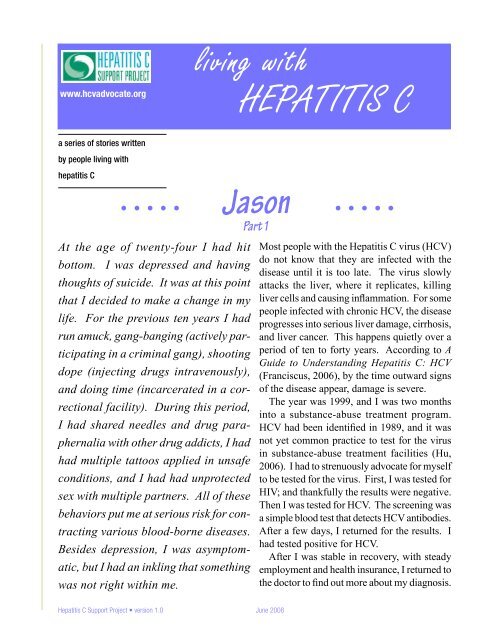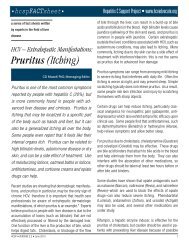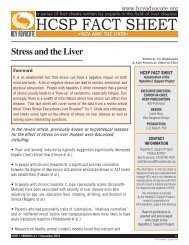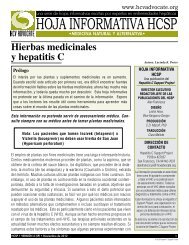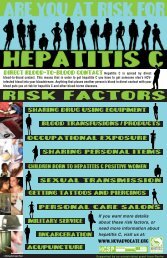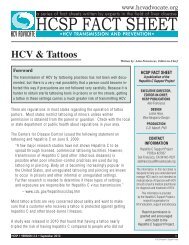Living with Hepatitis C - Jason's Story - Part 1 - HCV Advocate
Living with Hepatitis C - Jason's Story - Part 1 - HCV Advocate
Living with Hepatitis C - Jason's Story - Part 1 - HCV Advocate
Create successful ePaper yourself
Turn your PDF publications into a flip-book with our unique Google optimized e-Paper software.
www.hcvadvocate.orgliving <strong>with</strong>hepatitis Ca series of stories writtenby people living <strong>with</strong>hepatitis CAt the age of twenty-four I had hitbottom. I was depressed and havingthoughts of suicide. It was at this pointthat I decided to make a change in mylife. For the previous ten years I hadrun amuck, gang-banging (actively participatingin a criminal gang), shootingdope (injecting drugs intravenously),and doing time (incarcerated in a correctionalfacility). During this period,I had shared needles and drug paraphernalia<strong>with</strong> other drug addicts, I hadhad multiple tattoos applied in unsafeconditions, and I had had unprotectedsex <strong>with</strong> multiple partners. All of thesebehaviors put me at serious risk for contractingvarious blood-borne diseases.Besides depression, I was asymptomatic,but I had an inkling that somethingwas not right <strong>with</strong>in me.Jason<strong>Part</strong> 1Most people <strong>with</strong> the <strong>Hepatitis</strong> C virus (<strong>HCV</strong>)do not know that they are infected <strong>with</strong> thedisease until it is too late. The virus slowlyattacks the liver, where it replicates, killingliver cells and causing inflammation. For somepeople infected <strong>with</strong> chronic <strong>HCV</strong>, the diseaseprogresses into serious liver damage, cirrhosis,and liver cancer. This happens quietly over aperiod of ten to forty years. According to AGuide to Understanding <strong>Hepatitis</strong> C: <strong>HCV</strong>(Franciscus, 2006), by the time outward signsof the disease appear, damage is severe.The year was 1999, and I was two monthsinto a substance-abuse treatment program.<strong>HCV</strong> had been identified in 1989, and it wasnot yet common practice to test for the virusin substance-abuse treatment facilities (Hu,2006). I had to strenuously advocate for myselfto be tested for the virus. First, I was tested forHIV; and thankfully the results were negative.Then I was tested for <strong>HCV</strong>. The screening wasa simple blood test that detects <strong>HCV</strong> antibodies.After a few days, I returned for the results. Ihad tested positive for <strong>HCV</strong>.After I was stable in recovery, <strong>with</strong> steadyemployment and health insurance, I returned tothe doctor to find out more about my diagnosis.<strong>Hepatitis</strong> C Support Project • version 1.0 June 2008
It was at this point that I became motivated to learneverything that I could regarding this disease thatwas slowly eating away at my liver. I spent manyhours researching the disease, discussing it at length<strong>with</strong> my doctor and nurse, and attending various<strong>HCV</strong> support groups. Because of my experience,I am able to describe the pathology of the disease,analyze the social and psychological aspects of <strong>HCV</strong>infection, and evaluate the effects of the disease onthe individual and his or her family.The liver processes everything that is eaten,breathed, or absorbed through the skin. The liverstores vitamins and minerals for future use, and itproduces bile, which assists the body in digestingfood and absorbing nutrients as well as performingover 500 other critical functions <strong>with</strong>in the body. Itis the largest organ, weighing approximately threepounds, and it is about the size of a football. Theliver is an extremely vital organ <strong>with</strong>in the humanbody.The term <strong>Hepatitis</strong> is used to describe an inflammationof the liver (Thompson, 1968). <strong>Hepatitis</strong> isa potentially life-threatening disease that is oftencaused by a viral infection, but it is also caused byliver damage from exposure to toxic chemicals,drugs, and other factors. Six hepatitis viruses havebeen identified to date. These viruses are categorizedA through G. Of these six forms of viral hepatitis,<strong>Hepatitis</strong> A (HAV), <strong>Hepatitis</strong> B (HBV), and <strong>HCV</strong> arethe most common. These viruses are related only inthat they all cause liver inflammation.According to an article published in the InternationalJournal of Medical Sciences (Chen, Morgan.2006), <strong>HCV</strong> “is a leading cause of chronic liverdisease, cirrhosis, and hepatocellular carcinoma, aswell as the most common indication for liver transplantationin many countries.” Approximately 170million people worldwide are infected <strong>with</strong> <strong>HCV</strong>,<strong>with</strong> an estimated 3.5 million infected in the U.S.<strong>HCV</strong> differs from other types of viral hepatitis inthat it mutates frequently. This frequent mutationand the fact that there are numerous subtypes of thedisease have made it difficult to develop a vaccinefor the virus. There is currently no cure or vaccinefor <strong>HCV</strong>.The <strong>HCV</strong> virus was first isolated from the serum ofa person in 1989. Before this, the virus was referredto as “non-A, non-B hepatitis.” <strong>HCV</strong> is an RNA(ribonucleic acid) virus of the family flaviviridae.Other family flaviviridae diseases include denguefever and yellow fever (Akanksha, Mehta, 1999).The <strong>HCV</strong> virus replicates in the cytoplasm (fluidthat fills a cell) of hepatocytes (chief functionalcells of the liver). <strong>HCV</strong> infection relies upon rapidreproduction and continual cell-to-cell spread of thevirus. Persistent <strong>HCV</strong> infection also relies upon “alack of vigorous T-cell immune response to <strong>HCV</strong>antigens” (Chen, Morgan, 2006).How is <strong>Hepatitis</strong> C Transmitted?<strong>HCV</strong>, commonly thought to be the most severeof the hepatic viruses, is a blood-borne pathogen.It is caused by direct blood-to-blood contact <strong>with</strong>someone who is infected <strong>with</strong> the virus. I probablyacquired <strong>HCV</strong> through sharing needles when I was<strong>Hepatitis</strong> C Support Project • version 1.0 June 2008
an active intravenous drug user. Sixty percent ofthose infected <strong>with</strong> <strong>HCV</strong> in the U.S. are infectedthrough high-risk drug use (CDC, 2007). However,it is possible that I acquired the disease througha variety of other unsafe behaviors. <strong>HCV</strong> is alsotransmitted through exposure to unclean tattooing orbody piercing equipment; through intranasal cocaineuse; through sharing shaving razors, nail clippers,or toothbrushes <strong>with</strong> someone who is infected; andthrough unprotected sex <strong>with</strong> multiple partners. Iparticipated in almost all of these behaviors. Accordingto the American Liver Foundation (2007),<strong>HCV</strong> can also be transmitted through exposure tocontaminated blood among health care or publicsafety workers, by accidental needle-sticks, fromsolid organ transplants, in dialysis patients throughnosocomial spread, from an infected mother to herbaby at birth, and before 1992, through blood transfusions(America Liver Foundation, 2007).Although <strong>HCV</strong> is not exclusively considered asexually transmitted disease, there is a slight chanceof transmission through unprotected sex. This risk isfurther reduced when an <strong>HCV</strong>-infected individual isinvolved in a monogamous long-term relationship.Various published studies looking at the incidenceof sexually transmitting <strong>HCV</strong> produced varyingresults. For long-term monogamous relationships,the percentage of <strong>HCV</strong> being sexually transmittedis believed to be between zero and six tenths of apercent. The risk of sexual transmission is slightlyhigher, or one percent, for those in short-term relationships(<strong>Hepatitis</strong>-Central.com, 2007).Who Should be Tested for <strong>HCV</strong>?Individuals who have participated in high-risk behaviorssuch as intravenous drug use or unprotectedsex <strong>with</strong> multiple partners should be screened for<strong>HCV</strong>. Those who may have been exposed to <strong>HCV</strong>infectedblood and equipment, such as health careand public safety workers, those who have receivedblood, blood products or organ donations from an<strong>HCV</strong>-infected donor, and long term kidney dialysispatients should also be screened. Children whosemothers were infected <strong>with</strong> <strong>HCV</strong> at their time ofbirth and those who live <strong>with</strong> <strong>HCV</strong>-infected individualsand may have shared <strong>HCV</strong> blood exposeditems such as toothbrushes and shaving razors orhad sex <strong>with</strong> an <strong>HCV</strong>-infected partner should betested as well.<strong>HCV</strong> detection is a simple blood test. An ELISA(enzyme-linked immunosorbent assay) test is usedto detect <strong>HCV</strong> antibodies in the blood (MedicineNet.com, 2005). Antibodies are proteins found in theblood that are used by the immune system to detectand neutralize bacteria and viruses. The RIBA<strong>HCV</strong> test is another <strong>HCV</strong> antibody test that can beadministered. This test is sometimes administeredas a secondary test to confirm ELISA results. WhenI returned to the doctor two years after my initial<strong>HCV</strong> screening, I was given a variety of other teststo determine my viral load, genotype, and liver biochemical/functions.There are two blood tests that are administered todetermine active <strong>HCV</strong> infection. The first of these isthe Qualitative <strong>HCV</strong> RNA test. This test is reportedsimply as “positive” if active <strong>HCV</strong> is detected or“negative” if not detected. This test is often administeredafter treatment to determine whether the virushas successfully been eliminated from the body.The second test is the Viral Load Quantitative <strong>HCV</strong>test. This test measures the RNA (ribonucleic acid)particles in the blood. My viral load was over twomillion viral particles per milliliter of blood when Iwas first administered the Quantitative <strong>HCV</strong> test.I was also administered a genotype test to determinethe type of virus I carried. <strong>Hepatitis</strong>-Central.com (2007) explains that <strong>HCV</strong> is actually a range ofviruses that are similar enough to be called <strong>Hepatitis</strong>C, yet distinct enough to be divided into severalsubgroups. There are eleven genotypes of <strong>HCV</strong>,which are classified one through eleven. Some ofthe eleven genotypes are broken into subgroups a,b, c, d, and e. The genotypes commonly found inthe U.S. are types 1a and 2b. Genotype 1a is themost virulent of the <strong>HCV</strong> classifications and theone most resistant to treatment. I was diagnosed<strong>Hepatitis</strong> C Support Project • version 1.0 June 2008
<strong>with</strong> genotype 1a.During the process of my initial diagnosis, I wasgiven a hepatic panel that measured various liverfunctions. This series of blood tests measuredalanine aminotransferase (ALT) and aspartateaminotransferase (AST) enzyme levels in myblood. These are enzymes that are released intothe blood when the liver is damaged. My doctoralso recommended other tests intended to measurethe amount of bile duct blockage and cirrhosisas well as to measure blood clotting speed andbilirubin levels.– Jason C. Torojctoro@dons.usfca.edu<strong>Part</strong> 2 will focus on a discussion of acute vs.chronic, duration of disase and liver biopsy.Akanksha, M. (1999). <strong>Hepatitis</strong> C. Retrieved October 21, 2007, fromhttp://www.brown.edu/Courses/Bio_160/Projects2000/<strong>Hepatitis</strong>C/virmain.htmlAmerican Liver Foundation. (2007). <strong>Hepatitis</strong> C. Retrieved October21, 2007, from http://www.liverfoundation.org/education/info/hepatitisc/CDC. (2007). Viral <strong>Hepatitis</strong> C. Frequently Asked Questions.Retrieved October 21, 2007, from http://www.cdc.gov/ncidod/diseases/hepatitis/c/faq.htm#1b1Chen SL, Morgan TR. The Natural History of <strong>Hepatitis</strong> C Virus (<strong>HCV</strong>)Infection. Int J Med Sci 2006; 3:47-52. Retrieved October 22, 2007,from http://www.medsci.org/v03p0047.htmFranciscus, A. (2006). A Guide to Understanding <strong>Hepatitis</strong> C: <strong>HCV</strong>.Retrieved October 21, 2007, from http://www.hcvadvocate.org/hepatitis/About_<strong>Hepatitis</strong>_pdf/1.1_Hepatits_C/<strong>HCV</strong>%20Guide%2006_final.pdf<strong>Hepatitis</strong>-Central.com. (2007). Modified Hepatic Activity Index.Retrieved October 21, 2007, from http://www.hepatitis-central.com/hcv/biopsy/modified2.htmlHu, K. (2006). International Journal of Medical Sciences. Advancesin Managing <strong>Hepatitis</strong> C Virus (<strong>HCV</strong>) Infection. Retrieved October 21,2007, from http://www.medsci.org/hepatitisc.htmlMedicineNet.com. (2005). ELISA Tests. Retrieved October 21, 2007,from http://www.medicinenet.com/elisa_tests/article.htmThompson, M. (2004). <strong>Hepatitis</strong>. In K. Lee Lerner & Brenda Lerner(Eds.), Gale Encyclopedia of Science, Vol. 3. (3rd ed., 1966-1969).Detroit: Gale. Retrieved October 21, 2007, from Gale Virtual ReferenceLibrary via Thomson Gale: http://0-find.galegroup.com.ignacio.usfca.edu:80/gvrl/infomark.do?&contentSet=EBKS&type=retrieve&tabID=T001&prodId=GVRL&docId=CX3418501121&source=gale&userGroupName=usfca_gleeson&version=1.0Be Sure to Check OutThese Other Stories•Alan’s <strong>Story</strong>•Brian’s <strong>Story</strong>•Carol’s <strong>Story</strong>•David’s <strong>Story</strong>•Dee’s <strong>Story</strong>•Gerald Moreno’s <strong>Story</strong>•Jake’s <strong>Story</strong>•Kathleen’s <strong>Story</strong>•Leslie’s <strong>Story</strong>•Martha’s <strong>Story</strong>•Mike’s <strong>Story</strong>: <strong>Part</strong> 1•Rosa’s <strong>Story</strong>•Twila’s <strong>Story</strong>www.hcvadvocate.org/community/stories.aspFor more information about hepatitis C, hepatitis B and<strong>HCV</strong> coinfections, please visit www.hcvadvocate.org.Executive DirectorEditor-in-Chief, HCSP PublicationsAlan FranciscusDesignPaula Fener•hcspFACTsheet•A publication of the <strong>Hepatitis</strong> C Support ProjectProductionC.D. Mazoff, PhDContact information:<strong>Hepatitis</strong> C Support ProjectPO Box 427037San Francisco, CA 94142-7037alanfranciscus@hcvadvocate.orgThe information in this fact sheet isdesigned to help you understand andmanage <strong>HCV</strong> and is not intended asmedical advice. All persons <strong>with</strong> <strong>HCV</strong>should consult a medical practitioner fordiagnosis and treatment of <strong>HCV</strong>.This information is provided by the<strong>Hepatitis</strong> C Support Project • a nonprofitorganization for <strong>HCV</strong> education, supportand advocacy• © 2008 <strong>Hepatitis</strong> CSupport Project • Reprint permission isgranted and encouraged <strong>with</strong> credit tothe <strong>Hepatitis</strong> C Support Project.H C V A D V O C A T Ewww.hbvadvocate.org<strong>Hepatitis</strong> C Support Project • version 1.0 June 2008


